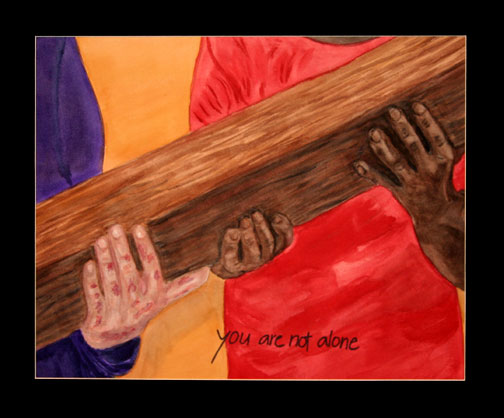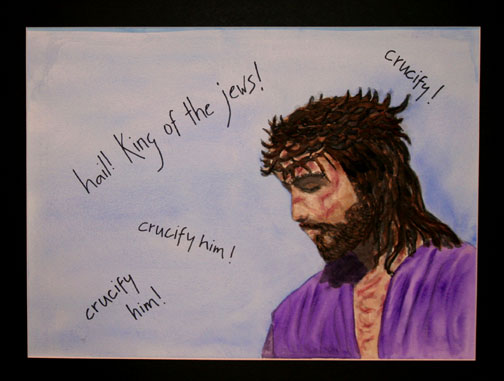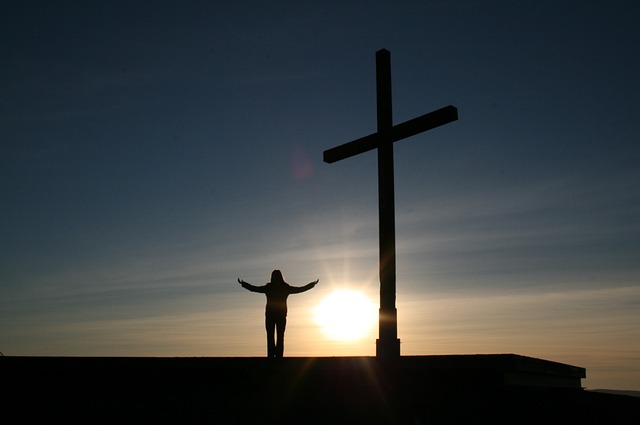
The Eleventh Station: Jesus Promises His Kingdom to the Good Thief
Three men being crucified, suffering excruciating pain, literally. (The word “excruciating” comes from the Latin cruciare, “to crucify.”) One man begins taunting Jesus, sarcastically calling out for salvation he believes Jesus can’t deliver. The other, sensing something that he has never felt before, defends Jesus as an innocent victim. Then, in desperate hope, he cries out: “Jesus, remember me when you come into your kingdom.” In response Jesus says a most astounding thing, a most encouraging thing, a most curious thing: “Truly I tell you, today you will be with me in Paradise.”
Read Article
The Tenth Station: Jesus is Crucified
“They crucified Jesus.” “They,” in this case, refers to the Roman soldiers. Rome alone had the authority and the audacity to crucify people, one of the cruelest forms of execution ever devised. Crucifixion was so disgusting that Roman authors rarely referred to it. It was better left unmentioned.
Read Article
The Ninth Station: Jesus Meets the Women of Jerusalem
Luke 23:27 notes that “a great number of people followed [Jesus]” as he walked to Golgotha. Luke gives no indication that they were crying out for Jesus’s death. In fact, by mentioning the women weeping for Jesus, Luke implies that at least many among the “great number of the people” were upset by what was happening to Jesus.
Read Article
The Eighth Station: Simon of Cyrene Helps Jesus to Carry the Cross
Christians from all over the world come to Jerusalem to walk along the Via Dolorosa, the way of suffering, the way of the cross. This path through the streets and alleys of Jerusalem is believed to be the path Jesus actually walked on the way to his crucifixion.
Read Article
The Seventh Station: Jesus Takes Up His Cross
Jesus had said this would happen. For quite some time he had predicted his suffering and death.
In the final events of his life, Jesus seemed to be orchestrating events that might otherwise have been out of his control.
So, though the crucifixion of Jesus is horrendous from one point of view, it is also wondrous from another perspective.
Read Article
The Sixth Station: Jesus is Scourged and Crowned with Thorns
What cruel irony! Jesus finally received the words he deserved: “Hail, King of the Jews!” For once he wore a crown upon his head. Yet it was not the golden crown of sovereignty or the olive crown of victory, but the thorny crown of suffering.
Read Article
The Fifth Station: Jesus is Judged by Pilate
There has been a tendency in the Christian telling of the Passion story to exonerate Pilate, or at least to make him an unwilling pawn of the Jewish leaders and crowds. Pilate, it is claimed, was a truth-seeking man who was caught between a rock and a hard place. Were it not for the pressure he received from the Sanhedrin and their supporters, he wouldn’t have crucified Jesus. This view of the noble Pilate seems at first to fit the facts of the New Testament Gospels. But, upon closer scrutiny, it falls short in a number of crucial ways.
Read Article
The Fourth Station: Peter Denies Jesus
Why did Peter deny Jesus? After all, he had been one of the first to follow Jesus, leaving so much behind to walk the uncertain road of discipleship. Peter had seen mighty wonders as his Master healed the sick, cast out demons, and even raised the dead. Peter had witnessed the miracle of the transfiguration. And he had even walked on water for a few brief moments. So why did Peter, of all people, deny Jesus?
Read Article
The Third Station: Jesus is Condemned by the Sanhedrin
Have you ever wondered why Jesus wasn’t clearer about who he was and what he had come to do? I certainly have. It seems like it would have been so much easier for all, including those of us who seek to follow Jesus today, if he had only said, “Yes, I am the Messiah, but not in the sense you expect. I have been anointed by God to bring the kingdom, but not in a military-political way. The kingdom is coming through transformed hearts, communities, and cultures. Most of all, the kingdom is coming through my death, as I bear the sin of Israel, and, indeed, the sin of the world. As Messiah, I must also suffer in the role of Isaiah’s Servant.” Yet Jesus didn’t say this directly. It’s something we have to piece together from his words and deeds.
Read Article
The Second Station: Jesus, Betrayed by Judas, Is Arrested
Betrayal. I expect many of us have experienced it, and often in the course of our work. Betrayal happens when someone we have trusted turns on us, rejecting us, perhaps even injuring us. It’s not uncommon for people who work in highly competitive companies or industries to experience betrayal several times throughout their career. In praying with people who have been deeply hurt by others. I’ve felt betrayed a few times. And, if truth be told, I expect some former colleagues might have felt betrayed by me, no matter what I had intended.
The second of the biblical Stations of the Cross draws our attention to the betrayal of Jesus by Judas.
Read Article
The First Station: Jesus on the Mount of Olives
Today, as we prepare for Holy Week and Easter, I’m beginning a 14-part series of devotions based on the biblical Stations of the Cross. You may be familiar with the traditional Stations of the Cross, which are common in Catholic churches and retreat centers. But you may not know that in 1991, Pope John Paul II published another set of stations, each of these based on biblical passages related to the Passion of Jesus. These biblical stations take us through the last day of Jesus’s life, allowing us to contemplate what he experienced and why it matters so much.
Read Article
Does Easter Have Anything to Do with My Work?
If we think beyond the Easter celebrations to the reality being celebrated, Easter may turn out to be more relevant to work than we first think.
Read Article
Lenten Journey, Part 4 – Surprise
Today is Holy Saturday – the day between Good Friday and Easter. In my experience, today feels a bit like an intermission in a play. Lots of drama happened before; lots of drama is yet to come.
Read Article
Lenten Journey, Part 1 – Gratitude
One of the things I didn’t much appreciate – and that my community didn’t emphasize – was the season of Lent. Perhaps you are in a similar situation. … Whether you are new to the season or are an experienced observer, I want to reflect with you every other Saturday this Lenten season on the above text from Psalm 50.
Read Article
How Does Ash Wednesday Relate to Our Work? Part 3
Today is the last of three devotions that respond to the question: How does Ash Wednesday relate to our work? Though the official recognition of Ash Wednesday happened two days ago, the fact of our mortality – the central meaning of the holiday – remains. We may not have ashes on our foreheads today, but we are still made from dust, and to dust we will return.
Read Article